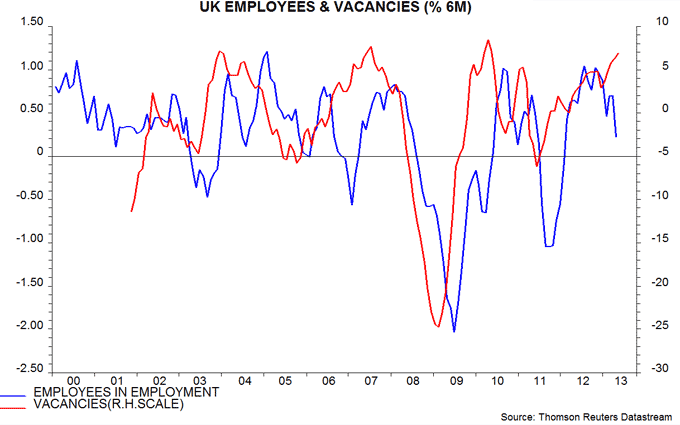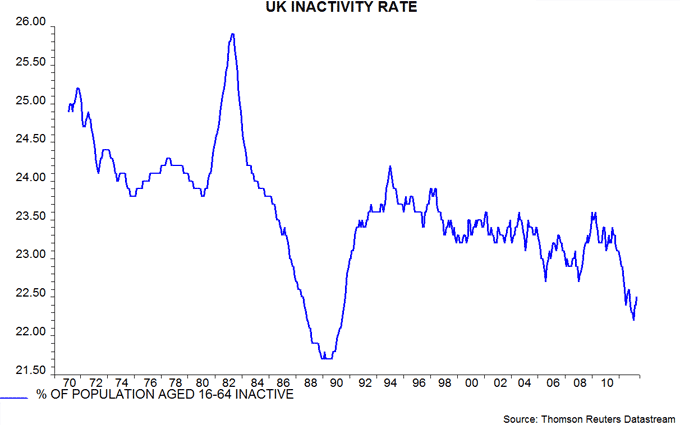UK unemployment could fall surprisingly fast
The UK labour market is strengthening rapidly, a trend that could undermine the impact of any new MPC commitment to maintain current policy until the unemployment rate falls to a given level.
The MPC is widely expected to specify one or more “intermediate thresholds” for policy tightening next month in an effort to anchor the short end of the yield curve and bolster consumer and business confidence. A threshold based on the unemployment rate would have the advantage of simplicity and would mirror the approach of the Federal Reserve, which has committed to maintaining current official rates at least until the unemployment rate falls to 6.5%, providing that inflation and inflation expectations remain contained.
The Fed has set its threshold 2.1 percentage points above the jobless rate low of 4.4% reached in 2006-07, judging this margin sufficient to exclude the possibility of unemployment falling to an inflationary level (i.e. to below the “NAIRU”, or non-accelerating-inflation rate of unemployment). The UK unemployment rate troughed at 4.7% in 2004-05 so an equivalent approach would involve setting the threshold at 6.8%, or 6.75% rounding to the nearest 0.25 percentage point.
The unemployment rate was 7.8% over March-May, or 7.77% before rounding. As explained below, it is likely to fall significantly over the remainder of 2013 and, if the trend is sustained, could reach 6.75% in mid-2014. Since markets do not currently expect an official rate rise until 2015, this suggests that a threshold set at 6.75% would have no beneficial impact and could even prove counterproductive, by sharpening investor focus on better-than-forecast labour market outcomes.
The arithmetic of this scenario is as follows. Vacancies lead employee numbers and rose by 7% over March-May from six months earlier. Historically, such an increase has been consistent with employee growth of about 1% over six months, or 2% annualised – see first chart. A 2% rate of expansion would create 590,000 additional employees by mid-2014 (i.e. over the 14 months from March-May 2013 to May-July 2014).
Total employment would probably rise by slightly less because some of the additional employees would be drawn from the currently self-employed. Suppose that total employment increases by 550,000 by mid-2014.
Unemployment also reflects expansion of the labour force (i.e. those in or actively seeking work). Labour force growth has averaged 0.6% over the last 40 years. This rate of increase would result in a 230,000 rise by mid-2014. Combined with a 550,000 increase in employment, this would imply a fall in unemployment from 2.505 million currently to 2.185 million, or 6.7% of the labour force.
Unemployment pessimists argue that any decline will be slowed by a return of “economically inactive” people to the labour force. At 22.5%, however, the inactivity rate is currently low by historical standards – second chart. The rise in inactivity in 2009-10 was surprisingly small compared with previous recessions and has been more than reversed subsequently. A further consideration is that working-age population growth has slowed – to only 0.1% in the year to March-May. Assumed labour force expansion of 0.6% annualised, therefore, seems reasonable.
The plausibility of the above scenario is supported by the latest data for the more timely claimant-count unemployment measure – jobless claims dropped 21,000 in June, close to the 23,000 average monthly decline needed for labour force survey unemployment to fall to 2.185 million by mid-2014.



Reader Comments